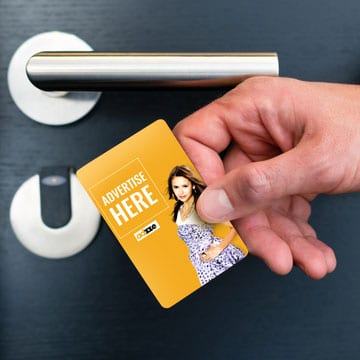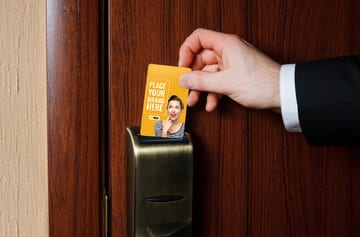
Key Card Advertising: The Impact of COVID-19
Key Card Advertising: learn how the current pandemic is impacting this advertising concept.
The domino effects from the COVID-19 crisis continue to impact all types of business causing need to change their advertising strategy. As the impact of COVID-19 continues to unfold, brands and agencies need to keep a up to date with the changing consumer behaviors and ensure they are prepared for any outcomes and find new opportunities.
At the end of March, Gartner reported that 65% of chief marketing officers (CMOs) surveyed were planning to cut marketing budgets as a result of business disruptions from the coronavirus. The survey showed that 34% of businesses expect “reduced levels of business operations” due to COVID-19, 10% expect operations to be severely restricted, and 2% will cease business operations.
A survey conducted by the platform Numerator indicated many industries are shifting their messaging to in-home delivery. As example, restaurants are pivoting to food delivery message. Numerator reported that Burger King and Little Caesars are even advertising new contactless payment and delivery options available in their stores.
Do you need more modern ads?
Adzze has been working with its clients to adapt to a more sensitive message. The team has been extending the capabilities to offer advertising options that can reach the consumers at the safest place: their home. One of these concepts uses pizza boxes as advertising space that gets delivered at the homes of the audience
Key Card Advertising depends on the hotel industry
As of October 2019, the occupancy rate of hotels in the US stood at 69.3%. For the past years since 2011, the industry has seen the occupancy rate grow year-on-year. The occupancy rate is a critical indicator of the health of the hotel industry. Notably, it helps businesses to make revenue projections and to decide on how to invest excess capital. However, the occupancy rate means a different thing to advertisers.
During this period, advertisers used hotels as a platform to push for more visibility for businesses. Notably, key cards make room accessibility easy, and hotels can map the movement of clients efficiently. It is crucial for security concerns.
The current pandemic drove the sales and hotel industry to the lowest levels ever seen. This had a direct impact on the key card advertising reach. By the end of second quarter of 2020, Barron’s projects that ad agencies would have lost billions of dollars from their income statements, leaving the future of media businesses endangered, if not crippled. Prior to the coronavirus outbreak, in December 2019, the U.S. ad market was projected to grow by 4.4%, mostly from selling ads related to politics and sports. But as of March 2020, revised forecasts indicate that Print and radio ad revenues are expected to drop by 25.4% and 14.1%, respectively, while OOH advertising will drop by 11.8%. Key card advertising will follow similar trend.
The traditional out-of-home is also declining
Traditional OOH advertising as billboards demonstrate a lack of targeting and tracking, low engagement , high costs, low ROI. Many commuters are subjected to dozens of billboards each day with limited attention span generating a low brand recall. Many cities in the world also prohibited the use of billboards due to its visual pollution. The targeting issues are very often addressed with alternative approaches as mobile billboards, digital OOH, ads on trucks and ads in places people don’t expect as flags, backpacks, inflatable objects, gas pump and balloons.
The anti-billboard movement is global. In 2007, the city of Sao Paulo passed the Clean City Law that banned erecting of billboards in the city. The law explicitly called out billboards (digital and traditional) as a form of visual pollution. Similarly, Chennai in India stopped companies from erecting billboards in the city. Similar moves are identifiable in Tehran, and some American states like Alaska, Hawaii, and Vermont.
Blank billboards and cancelled digital ads across the country and many parts of the globe is a strong pointer to how the coronavirus pandemic sweeping the world today has impacted sign advertising. The devastating effects of the pandemic on human lives could almost be likened to how terribly it has also dealt with businesses around the world. The hotel industry and key card advertising could feel similar effect.
Some out-of-home advertising firms have withdrawn their earnings projections for the year as a result of market uncertainties at the moment. A good number of businesses that will survive the pandemic will most likely have to struggle to find their footing again. Reports also say that digital ad giants, Facebook and Google have also had their shares of the downturn. Even Coca-Cola has soft-pedaled its marketing drives.
The Industry is shifting to In-Home Advertising
The New York Times aptly described the effect of the pandemic on outdoor advertising as a ‘seismic shock’. Even Coca-Cola is among the companies that have limited their ad campaigns during the coronavirus crisis, the New York Times report says. Long story cut short; a lot of companies are hitting the brakes on billboard ads and other forms of OOH advertising, and are also pulling back until the coast clears.
Advertising in malls, at bus stops, and bus shelter advertising are fast becoming replaced by in-home advertising. The impact of COVID-19 has kept normally mobile citizens inside their homes. Hence, the best ways to reach your audience and maintain brand visibility will be to take your products and services to them indoors, as it will be clearly unprofitable to place adverts on billboards that no one is seeing.
New age advertising methods as seen at Adzze, will not only attract more clients but will effectively engineer the on-boarding of major businesses as many begin to see the tremendous benefit of in-home advertising. With innovative methods such as ads placement on pizza boxes, we guarantee definite impressions of your brands on prospective customers because our approach delivers the brand directly into the hands of your target audience at their homes.
The advertisement is printed on pizza boxes (or pizza toppers) and shipped to the pizzerias that the advertiser selected. The advertising pizza venues distribute to the consumers locally or they deliver at their homes. These venues are recognized pizza chains, so the advertiser has exposure to reputable brands. The pizza box ads get delivered in the hands of the consumers at their homes reaching on average 45 min of brand exposure. Sometimes the consumer leaves the pizza in the fridge generating additional exposure. On average, each Pizza Box Advertising venue delivers 2,000 pizza box ads per month with an estimate 1.8M impressions/month.

In-Home Advertising with Pizza Boxes
There are few reasons why marketers would choose Pizza Box Advertising instead of other traditional media vehicles:
High Brand Recall
Consumers are overwhelmed with digital ads that they see for a fraction of second and barely remember them. The attention span for digital ads is minimal to make them remember. The pizza box ads create a surprise effect making it more memorable. Studies show that this type of ads can evoke an 80% recall rate (8 out of 10 households individuals remember to see an ad on pizza boxes).
Low Cost
The budget used to place a 1 billboard on a high traffic highway for 1 month can be re-allocated to distribute 60,000 pizza boxes. This is sufficient to cover all households of a small town in the USA.
High Return on Advertising Spend
The average ROI is 2.5X. This means, for every 1 dollar the advertiser invested in a pizza advertising campaign, they received at least additional 2.5 dollars of sales.
Adzze is currently shifting the advertising methods to a more sensitive approach by reaching consumers at the safest place: their homes

